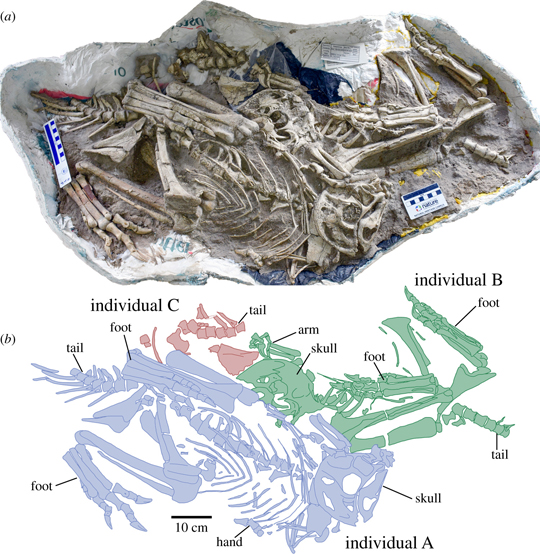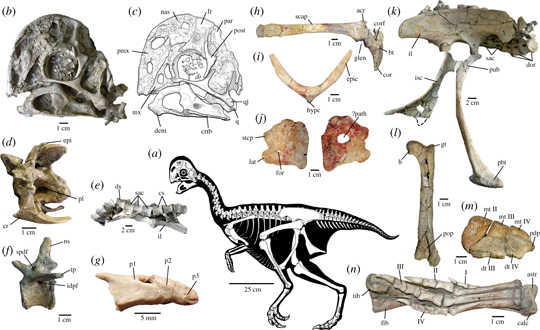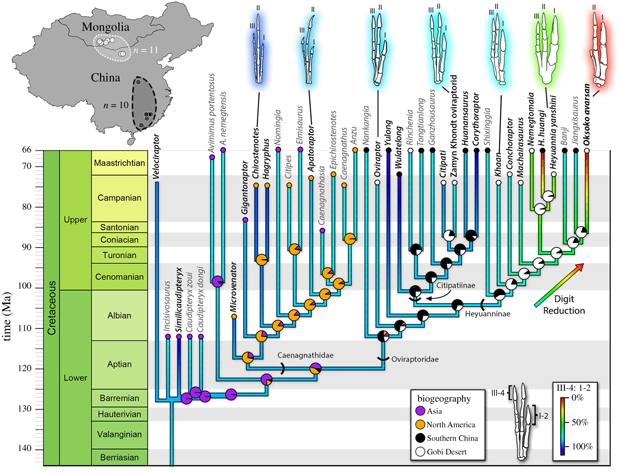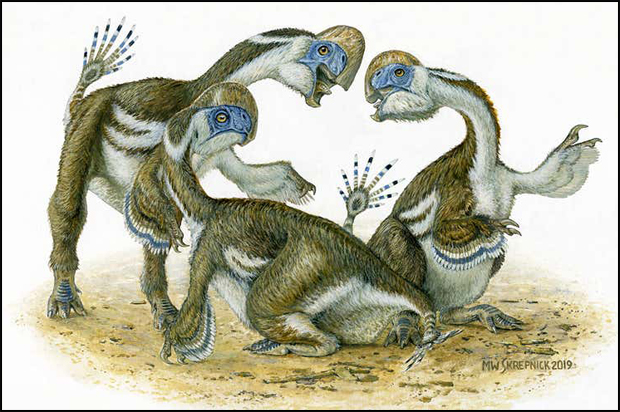Oksoko avarsan – New Species of Oviraptorosaur with Two Fingers
That inappropriately named clade of “Egg Thief Lizards”, the Oviraptorosauria has a new member. Standing around one metre high at the hips, the newly described Oksoko avarsan (Oak-soak-oh), which had just two digits on each hand, instead of the default Oviraptor setting of three, is helping palaeontologists to understand the radiation and success of these feathered dinosaurs.
A Life Reconstruction of the Newly Described Oksoko avarsan
Picture credit: Michael Skrepnick
The First Evidence of Digit Loss in the Oviraptorosaurs
Over the last forty years or so, lots of new oviraptorosaur theropods have been named and described, principally from fossil finds made in China and Mongolia. These feathered dinosaurs were highly successful and although their origins are uncertain, this type of dinosaur probably evolved in the Early Cretaceous of northern China and by the Late Cretaceous they had spread across much of Asia and into North America.
Whilst most palaeontologists confronted with the wealth of fossil material would concede that these theropods were geographically widespread, little research has been undertaken to ascertain the reasons for their evolutionary success. The discovery of Oksoko with its reduced forelimb with only two functional digits suggests that this group could alter their diets, behaviours and habits which enabled them to diversify and multiply. In essence, variation in forelimb length and hand morphology provides another example of niche partitioning in oviraptorosaurs, which may have contributed to their incredible diversity in the latest Cretaceous of Asia.
The Holotype Block Containing Three Specimens of O. avarsan

Picture credit: Funston et al (Royal Society Open Science)
Gregarious Behaviour in Oviraptorids
Oksoko is known from four specimens, a group of three (see picture above) and a fourth specimen found in the same crouched position that is believed to come from the same location. All the fossil material was confiscated from poachers so the exact discovery site of these fossils remains unknown. However, the researchers have confidently assigned them to the Nemegt Formation of the Gobi Desert and the material is estimated to be around 68 million years old.
It had long been suspected that oviraptorosaurs were gregarious social animals. The finding of three individuals preserved together represents the first, definitive evidence that these animals probably lived in groups and that they were gregarious. The fossil bones of all four individuals have provided the researchers with an almost complete skeleton of this two-metre-long dinosaur to study.
Key Fossils Representing the Anatomy of Oksoko avarsan

Picture credit: Funston et al (Royal Society Open Science)
Oksoko avarsan – A Three-headed Eagle
The scientists which included Dr Gregory Funston (Edinburgh University) and Phil Currie (University of Alberta), named this dinosaur after the three-headed eagle of Altaic mythology, a reference to the holotype block which contains the skulls of three individuals. The species or trivial name is from a Mongolian word for “rescued”, it alludes to the fact that these fossils were recovered from poachers.
The remarkably well-preserved fossil material provides the first documented evidence of digit loss in the usually three-fingered Oviraptorosauria. The holotype block material represents the remains of three dinosaurs that were approximately the same size and bone histology reveals that these animals died when they were around a year old. The fourth specimen is believed to represent an older animal that died around the age of five.
Commenting on the discovery, Dr Funston remarked:
“Oksoko avarsan is interesting because the skeletons are very complete and the way they were preserved resting together shows that juveniles roamed together in groups. But more importantly, its two-fingered hand prompted us to look at the way the hand and forelimb changed throughout the evolution of oviraptors — which hadn’t been studied before. This revealed some unexpected trends that are a key piece in the puzzle of why oviraptors were so diverse before the extinction that killed the dinosaurs.”
Finger Loss in a Dinosaur Family
Oksoko is the sixth genus of the Oviraptoridae family to be named from fossils associated with the Nemegt Formation. This demonstrates the diversity of these types of dinosaurs in the Late Cretaceous of China.
The other five oviraptorids known from the Nemegt Formation of Mongolia as stated by Everything Dinosaur team members are:
- Rinchenia mongoliensis
- Nomingia gobiensis
- Nemegtomaia barsboldi
- Gobiraptor minutus
- Conchoraptor gracilis
In addition, a number of closely related dinosaurs are known from the Nemegt Formation including the caenagnathid Elmisaurus rarus
The scientists produced a phylogeny of the Oviraptorosauria based in a reduction in size and eventual loss of digit III as shown in the most derived form described to date (O. avarsan) and a corresponding increase in size and robustness of digit I. They concluded that the arms and hands of these dinosaurs changed radically in conjunction with migrations into new geographical areas and presumably different habitats – specifically to what is now North America and the Gobi Desert.
Plotting the Change in Hand Morphology and the Radiation of the Oviraptorosauria

Picture credit: Funston et al (Royal Society Open Science)
To read a related article that considered the holotype block as evidence for communal roosting in oviraptorids: Three Theropods Preserved in a Resting Pose.
The scientific paper: “A new two-fingered dinosaur sheds light on the radiation of Oviraptorosauria” by Gregory F. Funston, Tsogtbaatar Chinzorig, Khishigjav Tsogtbaatar, Yoshitsugu Kobayashi, Corwin Sullivan and Philip J. Currie published in Royal Society Open Science.
The award-winning Everything Dinosaur website: Everything Dinosaur.







Leave A Comment